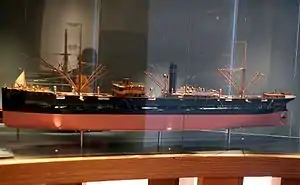SS Clan Alpine (1899)
Clan Alpine was a steam ship built in 1899 by the William Doxford & Sons of Pallion. She was the second ship named Clan Alpine in service with the Clan Line used on their Oriental routes.
 Scale model of the Clan Alpine | |
| History | |
|---|---|
| Name | Clan Alpine |
| Owner | Clan Line Steamers Ltd |
| Operator | Cayzer, Irvine & Co Ltd |
| Builder | William Doxford & Sons, Pallion |
| Yard number | 273[1] |
| Launched | 22 September 1899 |
| Sponsored by | Miss Greta Doxford |
| Christened | Clan Alpine |
| Commissioned | November 1899 |
| Homeport | Glasgow |
| Identification |
|
| Fate | Sunk, 10 June 1917 |
| General characteristics | |
| Type | Cargo ship |
| Tonnage | |
| Length | 355 ft 0 in (108.20 m) |
| Beam | 45 ft 6 in (13.87 m) |
| Depth | 24 ft 7 in (7.49 m) |
| Installed power | 330 Nhp[2] |
| Propulsion | William Doxford & Sons 3-cylinder triple expansion |
| Speed | 12.0 knots |
Design and construction
In 1899 Clan Line sold their old steamer Clan Alpine, and placed an order with William Doxford & Sons of Pallion to build three ships for them (future Clan Alpine, Clan Farquhar and Clan Urquhart). The ship was launched on 22 September 1899[3] (25 September 1899 according to other source[4]), with Miss Greta Doxford, daughter of William Theodore Doxford, being the sponsor. The vessel was commissioned in November of the same year.[1] As built, the ship was 355 feet 0 inches (108.20 m) long (between perpendiculars) and 45 feet 6 inches (13.87 m) abeam, a mean draft of 24 feet 7 inches (7.49 m).[2] Clan Alpine was assessed at 3,587 GRT and 2,285 NRT.[2] The vessel had a steel hull, and a single 330 nhp triple-expansion steam engine, with cylinders of 25+1⁄2-inch (65 cm), 42-inch (110 cm), and 69-inch (180 cm) diameter with a 48-inch (120 cm) stroke, that drove a single screw propeller, and moved the ship at up to 12.0 knots (13.8 mph; 22.2 km/h).[2]
Operational history
In early 1900s, the Clan Line operated two main routes between United Kingdom and her colonies in the East. The first one was a direct route from the home ports through the Strait of Gibraltar, Suez Canal and to the ports of India and Ceylon. The second one involved sailing down the western coast of Africa first to the ports of South African colonies, then onto the ports of Ceylon and India, and occasional trips to Australia.
Upon delivery, Clan Alpine proceeded to Middlesbrough and from there to Glasgow for loading, where she arrived on 18 November 1899. From there, the ship sailed to Liverpool and Manchester to load more cargo. She departed from Manchester to Bombay for her maiden journey on 12 December 1899,[5] passing through Suez Canal on 30 December and arriving in Bombay on 13 January 1900.[6] After calling at several Indian ports Clan Alpine left for England, passed through Suez Canal on 13 February and arrived in Dunkirk on 3 March.[7] After unloading the ship proceeded to England and arrived at Greenock on 15 March.[8] After a brief stop, the ship left Greenock on 22 March 1900, stopped to load cargo at Liverpool and departed from there for Cape Town on 29 March.[9][10] After calling at various South African ports the ship sailed to Ceylon via Mauritius and arrived at Galle on 3 July.[11] From Galle the ship continued on to India including Madras, where she arrived on 28 July. From India Clan Alpine departed for England via Colombo and arrived in London on 8 September 1900[12] before continuing on to Glasgow which she reached on 22 September.[13] She soon departed for another trip, leaving from Liverpool for Calcutta on 6 October 1900.[14]
Clan Alpine continued service on both routes through the rest of her career.
On 22 November 1908 Clan Alpine departed Liverpool for South Africa.[15] On 11 December 1908 it was announced that Clan Alpine was chartered to transport wheat from South Australia to England and Europe.[16] The vessel arrived at Cape Town on 19 December 1908 from Liverpool,[17] left there on 23 December, calling at Mossel Bay and Port Elizabeth and arriving at East London on 31 December 1908.[18] Clan Alpine departed from East London on 2 January 1909 and continued on to Australia. She arrived at Adelaide from East London in South Africa on 23 January 1909 and immediately continued on to Geelong[19] arriving there three days later.[20]
Sinking
On 10 June 1917 Clan Alpine was torpedoed and sunk 40 nautical miles of Muckle Flugga, Shetland Islands on a passage from Tyne to Archangel with a loss of 8 crew by German submarine U-60.
Notes
- "Wear Built Ships: Clan Alpine". Retrieved February 12, 2018.
- Lloyd's Register, Steamships and Motorships. London: Lloyd's of London Press Ltd. 1906–1907.
- Marine Engineer and Naval Architect, v. 21, p.367 (1899)
- Engineer, p.361 (1899)
- London Standard, December 14, 1899, p.8
- London Standard, January 15, 1900, p.8
- London Standard, March 5, 1900, p.8
- London Standard, March 17, 1900, p.10
- London Standard, March 24, 1900, p.9
- London Standard, March 30, 1900, p.9
- London Standard, July 5, 1900, p.10
- London Standard, September 10, 1900, p.9
- London Standard, September 25, 1900, p.11
- London Standard, October 8, 1900, p.10
- London Standard, November 24, 1908, p.3
- Daily Commercial News & Shipping List, December 11, 1908, p.4
- London Standard, December 23, 1908, p.3
- London Standard, January 4, 1909, p.3
- The Age, January 25, 1909, p.4
- Geelong Advertiser, January 27, 1909, p.6